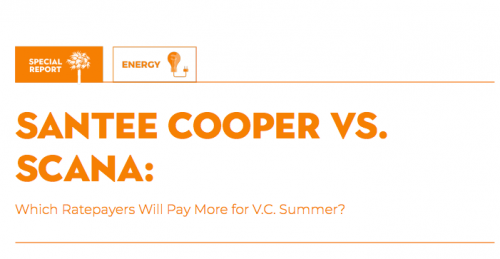Santee Cooper vs. SCANA – Which ratepayers will pay more?
While much of the failed V.C. Summer nuclear debacle’s attention has been focused on SCE&G parent company SCANA and its customers, a newly released economic analysis from the Palmetto Promise Institute finds it is Santee Cooper ratepayers who face a much more uncertain and unsettling future.
The analysis shows Santee Cooper ratepayers could shoulder as much as triple the burden of SCE&G customers over the coming years.
“SCE&G customers have already paid nearly $2 billion for their utility’s mismanagement, so there has been much more outcry from that constituency and more attention placed on them,” said Ellen Weaver, President & CEO of Palmetto Promise Institute. “However, Santee Cooper ratepayers’ pain is yet to come and Santee Cooper customers can expect to pay – in a best case scenario – a minimum of 50 percent more than SCE&G customers over the course of V.C. Summer debt repayment.”
The analysis, conducted by Katie Player, PhD, of the Department of Accounting & Finance of Wofford College, attributes the problems for Santee Cooper to three primary areas:
- Based on the size of the customer base, Santee Cooper ratepayers could pay more per individual to the tune of more than $50,294 over the life of the debt, or more than triple the approximately $15,000 each SCE&G customer will pay. Even if Central Electric Power Cooperative agrees that co-op customers will pay higher rates, an issue which faces great uncertainty at the moment, Santee Cooper and co-op customers would still be paying at least $20,835 each over the next 38 years.
- Santee Cooper has collected much less to fund the failed project, meaning they have a much higher hill to climb. Furthermore, SCANA has begun to pay against the principal while Santee Cooper has merely been servicing interest on its V.C. Summer debt.
- Santee Cooper has no equity stakeholders to help absorb the costs. Due to SCE&G’s structure, the utility has shareholder equity, which can absorb part of the losses by reducing some of the earnings otherwise retained by common shareholders. Santee Cooper is expected to recover the entire cost of the project through future rate increases and has no equity base.
A yet-to-be-determined factor relates to Santee Cooper’s current litigation with the Central Electric Power Cooperative, which purchases electricity for co-ops in all 46 counties. If Santee Cooper loses, it would place all the costs for V.C. Summer on the backs of the remaining Santee Cooper customers. At best, the amount needed to pay off the project per residential customer will be at least 50 percent higher for Santee Cooper customers than SCE&G customers, or over 300 percent higher if Central is able to avoid rate increases for its customer base.
“While we don’t know yet what the exact number will be, Santee Cooper customers should expect to pay significantly more than SCE&G customers for the failed V.C. Summer nuclear project,” said Dr. Katie Player. “Santee Cooper financials are not nearly as clear as SCANA about how much it has already collected and the risks it faces going forward, but our analysis of the information they have reported, and the charges and expenses on their balance sheet, show that Santee Cooper’s customers are going to be seeing much higher rates over a period of at least 38 more years to pay off the debt from the South Carolina nuclear debacle.”
Read all of the Palmetto Promise Institute’s research on Santee Cooper here.







